Customers frequently ask us how to make chainmaille clothing. While maille clothing may not be our main focus here at Blue Buddha, many of our project designers do create chainmaille clothing pieces as part of their own lines and artistic visions. To address this question, we turned to two of them: Omni Mee and Kat Wisniewski.
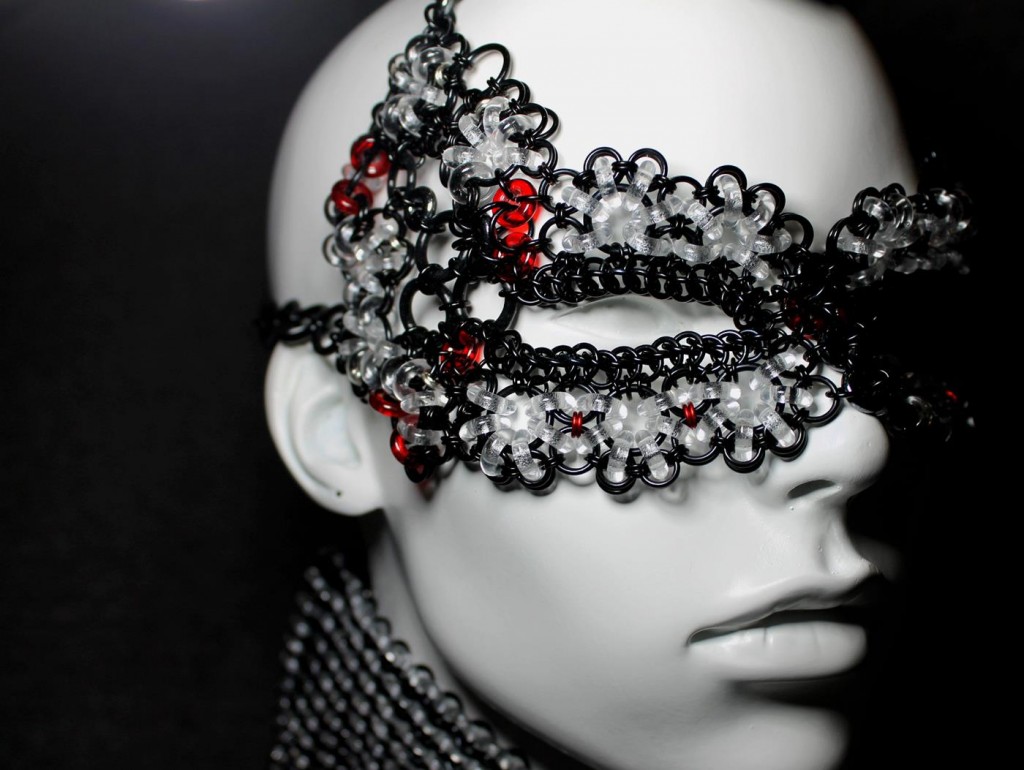
As you’ll see from their responses, there is no one way to approach making work like this. As with any art making, it comes down to the individual to determine the best process and way to achieve you vision. That said, there are lots of good little tips and insights in what they had to share.
Thanks to everyone who submitted questions for this post. Stay tuned to our blog as we pick the brains of even more artists and make sure to send us YOUR burning questions next time!
Do you have experience making clothing with tradition materials? Do you think it’s important to be familiar with the skills needed to do so before attempting to make mail clothing?
OMNI: Yes, I have experience with making clothing, although not a lot. I took a class in fashion sewing when I was in college; while I can make something in cloth, it may not be great. Traditional sewing skills may not be necessary, but they do help in the understanding of ideas such as darts, seams and order of how to put panels together.
KAT: No experience making clothing, but it may have been helpful to understanding how fabric moves along different parts of the body. I felt like I just made my pieces work on the mannequins & models by doing quite a bit of futzing and many fittings.
How do you determine which weave(s) will work best for your project?
OMNI: I determine a weave based on four factors, how fast I can make it, appearance of the weave, the material I intend on using, and how seams would work with the weave.
KAT: I created an entirely original weave for the rubber bikini and just repeated a 1.5” x 1.5” unit weave over a hundred times and connected them together. I only knew that I wanted it to look like it was macrame or crochet and in the end it did. For the glass cape (shown below), I knew that it had to be flexible like fabric, so I went with a European 4-1 on the bias pattern. The mask had to be somewhat stiff which is why I chose a japanese based pattern. It all depends on the project and how it should move.
We had several people ask about choosing ring size for these projects. How do you go about doing this? Do you make swatches like someone might do for knitting to determine rings per inch, etc.?
OMNI: There are ring calculators out there, but they only have a few weaves they can calculate. I have also done test swatches to get an idea of how many rings it would take.
KAT: No swatches. I experiment with ideas or weaves that I already know and enhance them or alter them to work for what I want to make. I usually increase the aspect ratio and add extra rings to get a new take on a weave I already know.
Speaking of rings per inch, how do you approach figuring out how many rings your project will need?
OMNI: I start with a pattern and figure out the area I would need to make. Then multiply by the rings pre inch to come up with a rough amount needed, then I add some just to make sure I have enough.
KAT: I was only able to figure out how many I needed after I really got further into the project. I needed to physically see how the piece was coming together and fitting to make final determinations on length, width, etc. I found that no matter my sketches or initial ideas on ring counts, it always changed as the piece morphed. It also came down to time and if I couldn’t finish my original idea in time, then I had no choice but to alter it into a different idea.
For any of your projects, did you start with a pattern? Is it possible to adapt patterns found in sewing stores for maille?
KAT: I did not start with any patterns only a few ROUGH sketches. I work best when I have a slight idea of what I want to do, then I just start making something that I think might work. (If I think too long about it, I get discouraged about how to make it work!) Once I get it started, I just keep adapting the weaving to fit my changing ideas until I have finally developed a finished product that I’m happy with.
How do you translate things like seams, bias cuts, etc. into mail?
OMNI: Good understanding of weave and how it reacts, there is a lot already written about some common weaves, but you may have to do your own experiments based on the weave you want to use and the pattern.
The thing to remember is that chainmaille weaves do not typically have a curve in the weave so you have to use straight lines for the most part. Depending on the weave used you may need to experiment with seam angles. There is an article in M.A.I.L. Artisans by Celtic_Chainman, called “The 45 Degree Seam Myth” I used as reference when I created the pattern for Violet Vestment.
How do you deal with fitting a piece to specific measurements? What if you have to resize something?
OMNI: I tend to start with making the pattern to the individual, that way I know it will fit. If you have to add or subtract, I would recommend adding to the center back seem when possible.
KAT: When I had 2 people model the bikini (shown above), I had to make many adjustments each time to fit each person. I took many measurements for each of the models and tried my best to get close to their sizes. Resizing was tough, but it worked out well in the end.
Dress forms can be really expensive, do you know of anywhere to buy inexpensive forms? What about dress form alternatives?
OMNI: The dress form I use I got from Robert H Ham, but it is a display dress form not an adjustable model used for sewing. I would recommend checking with your local fabric or sewing stores, they may have old floor models, know people who are looking to sell one, or have one for rent.
KAT: Craigslist & Ebay has some deals on dress forms. Also if you are making pieces to fit yourself, you can make a duct tape dress form of your body and then attach that to a dress form. You may need to use foam to fill the negative space in between the dress form and your duct tape body. I’ve also gotten 3 of my mannequins from stores that were closing or changing their clothing line and didn’t need certain mannequins anymore.
What kinds of closures do you recommend using for clothing pieces?
OMNI: Short answer is, the same as I would use for most articles of clothing, zippers. If you use zippers you will have to add grommets to the zipper.
Maille clothing looks great but isn’t always “street legal”…*wink*. Do you have recommendations for lining pieces to make them more wearable?
OMNI: I would recommend wearing a “nude” colored slip or under garments. Another option is to make lining by using the pattern you used to create the garment; you will probably have to add fabric for seam allowances.
If you want to avoid it all together choose denser or tighter weaves. That way what is seen beyond the chainmaille is very little if anything.
KAT: It all depends on your customer. Performers and dancers love unique pieces for their performances and may not mind if it is not lined.
Learn more about Omni Mee
Etsy page: http://www.etsy.com/shop/entropyware
Learn more about Kat Wisniewksi
Website: http://www.elementalartjewelry.com/
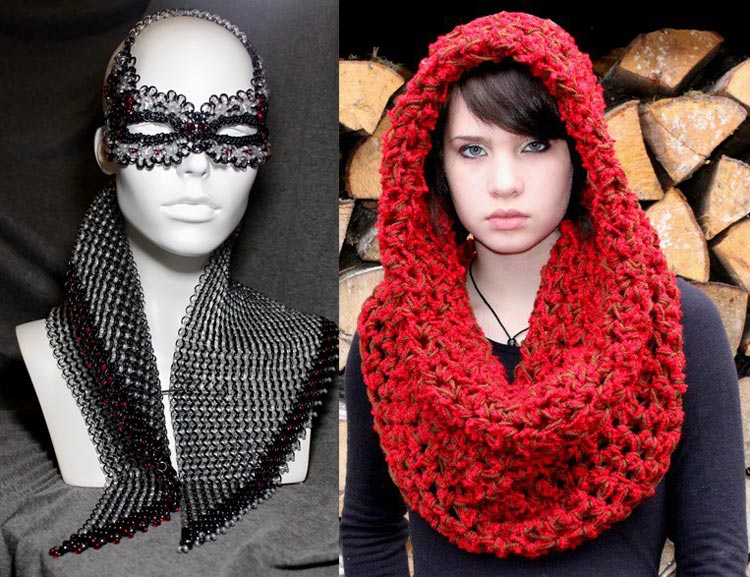
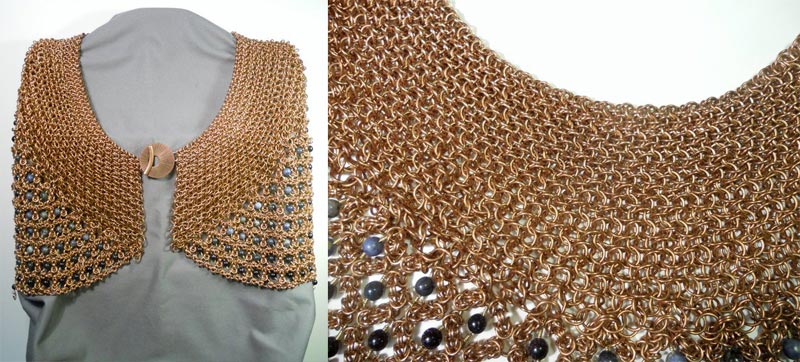
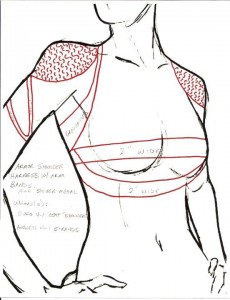
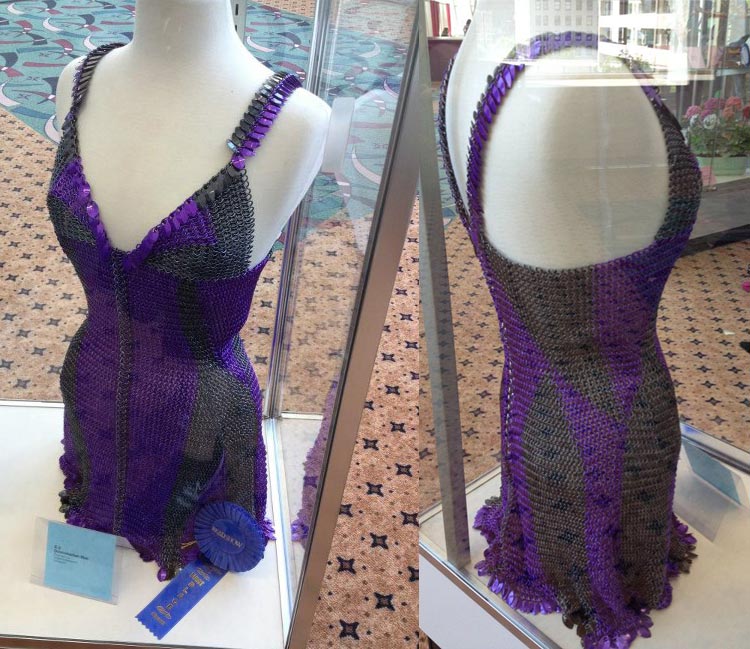
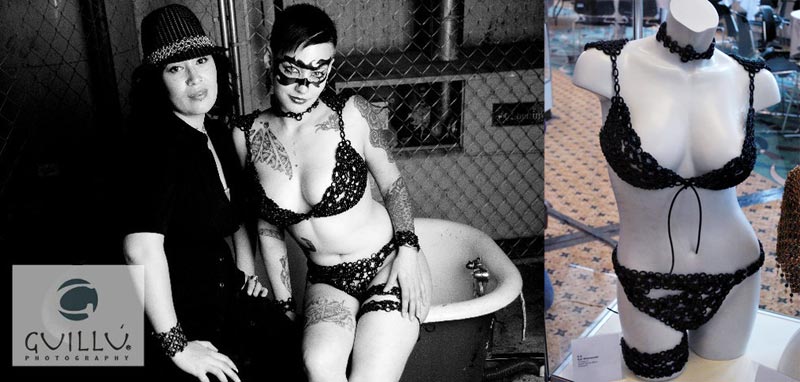
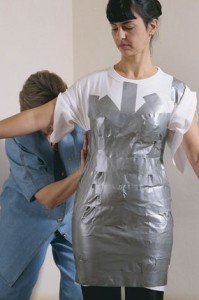



Thanks so much, Kat and Omni, for this very useful discussion! It’ll be fun to see how maille continues to expand beyond jewelry and evolve beyond basic boxy designs like shirts over the next few years. It has been interesting to see maille becoming more prevalent in the high-end fasion world via designers such as Fannie Schiavoni.
I’ve been mulling over a lot of this as I continue to work on designs that involve lots of maille and other metal components. Adding maille as a design element to fiber-based pieces is an intermediate strategy that I’m pursuing (Anillarte and Bibian Blue are examples; they often have corset foundations).
Kat’s comments about fittings reminds me of a comment I saw on Gail Be’s site about one of her amazing beaded dresses: “it still takes 3 people and a ladder to get her into this”.